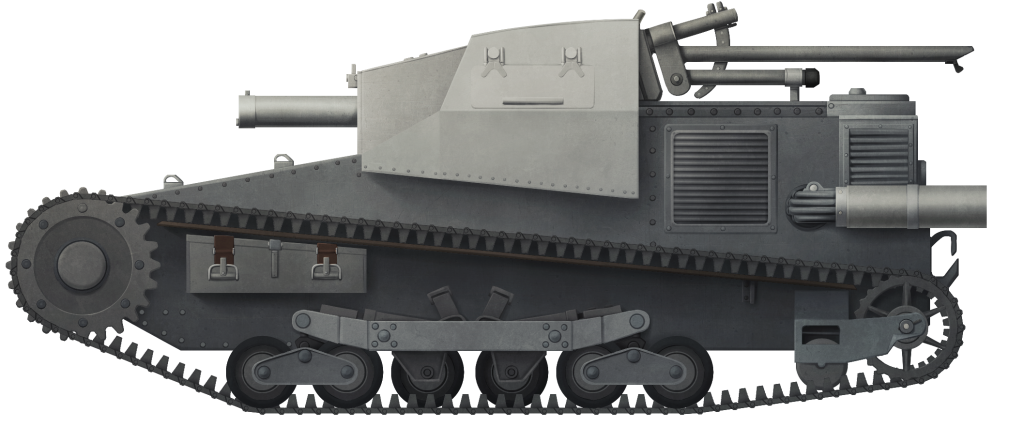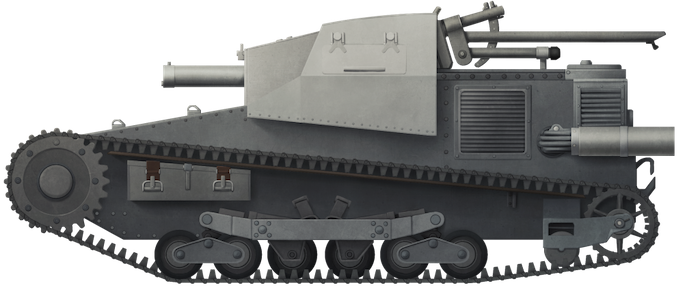 Kingdom of Italy (1929-1930)
Kingdom of Italy (1929-1930)
Light Tank – 1 Built
Following tests in 1930 with a new and improved light tank to replace the interim CV29, changes had to be made to the vehicle to improve mobility. Ansaldo had made the prototype in 1930 copying the general arrangement of the CV29, which was, in turn, a copy of the Carden-Loyd Mark VI light tank. The 1930 vehicle had improved armor by virtue of a proper roof plate and better suspension than the CV29, but it was still not acceptable. The armament was light, just a single FIAT Model 1914 water-cooled 6.5 mm machine-gun, and whilst that would be changed later, the priority was to achieve better mobility by focusing on the suspension system.
The 1930 Light Tank Prototype was modified and from the few available photographs and records on the project, the evolution from CV29 to CV3 Series vehicles can be traced directly through this 1930 vehicle modified into the 1931 model.

Trial and Development
With the lessons from the trials of the CV29 and the 1930 Ansaldo Light Tank Prototype available, the evolution of the CV3 had moved significantly in just a couple of years. The 1930 trials of the Light Tank had been promising, and new trials were ordered for 1931. Giuseppe Rossini, the engineering brains behind the designs at Ansaldo, took this knowledge and experience and replaced the suspension on the 1930 vehicle. It is not clear whether the suspension was changed from the 1930 vehicle to the 1931 vehicle first and then was copied over onto the Ansaldo Light Tractor (for hauling field guns) or vice versa, or indeed if it was done simultaneously, but regardless, the old suspension was gone and a new, improved system fitted.
Layout
As this 1931 vehicle was simply the 1930 vehicle with modifications, it retained the all-welded upper bodywork with bolting and riveting kept to the lower sections. The armament remained weak however, as it retained the same single FIAT model 1914 6.5 mm water-cooled machine-gun mounted behind a large, curved mounting on the front left. This would still be operated by the commander/gunner with the driver sitting on the front right. Movement for the machine-gun was acceptable as it was able to move 20 degrees in each direction horizontally and could be elevated between -12 and +18 degrees, thus permitting a wide field of fire. An estimated 3,800 rounds could have been carried, but as it was a prototype, this is not definitive and is merely an estimate based on the loadout of the CV3/33 when it was eventually finished.
The engine was at the back and the transmission at the front with the drive shaft running between the two men. The body of the vehicle was mostly welded armor between 8 and 14mm thick with some bolts used to attach sections together. Notably, the vertical front plate on the nose of the vehicle was bolted together and used two vertical reinforcing pieces. On the glacis, above this nose, was a single, wide hatch used for accessing and also for cooling the transmission.

On the casemate itself was a wide rectangular hatch on the front right for the driver in addition to a large rectangular hatch on the right of the driver for vision. Another two square hatches were provided in the back of the casemate directly behind the driver and gunner respectively. The roof was a single large metal panel attached by two simple hinges at the back of the casemate, being large and awkward to open and close.
At the rear, the engine bay had a flat roof, and ventilation for the engine was provided by means of large louvred grilles on each side of the engine compartment. On the roof of the engine compartment, there were more ventilation louvres. One unusual feature is the addition of ventilation grooves into the cover for the muffler on the exhaust from each side, presumably there to help keep the exhaust cool or assist in air flow.

Mobility and Suspension
The suspension was changed from 3 pairs of wheels to the better known 2-1-1-2 arrangement in which the fore and aft pairs of wheels were mounted on a bogie and the central individual wheels mounted on a dog-leg shaped arm. The horizontal supporting bar for the suspension components was retained, although it was shorter and slightly reshaped. The rear idler mount was also changed from a simple bar holding it in place to an integrated mounting holding a small wheel to keep the track from excessive flexing during high-speed movement and especially from being buckled upwards during reversing. As with all of the previous vehicles, the slightly triangular box behind the sprocket was retained and hand tools for the tank were kept in it.

The power source for the vehicle is not known for certain, although it is possible, albeit unlikely, that it was still using the same 2.9-litre Ford Model T petrol engine as was being used in the CV29. That engine produced just 20-22 hp for a vehicle over a tonne lighter. Performance for the 1931 Prototype is not known but had it been using this Ford engine it would have been totally unsatisfactory mobility wise, meaning it is far more likely to have had the same FIAT CV3-type 4 cylinder petrol engine as was later adopted for the production vehicles. That 2.745-litre engine received various improvements and modifications to improve the power output. As the production engine in the formally adopted CV3/33 delivered 43 hp, it is a reasonable assumption to place the engine output for the 1930 prototype at or about 43hp. In this case, this would have enabled to the tank to manage about 40km/h on a road and about 14 km/h off-road.
Conclusion
The 1931 Prototype with the improved suspension was still not perfect but was superior to its earlier (1930) form and significantly better in every regard than the CV29 which had been made as an interim tank whilst this new tank was developed. The FIAT model 1914 water-cooled 6.5 mm machine-gun was still not ideal, but that was to be a relatively simple thing to change. The design for the new tank had been set. Able to be transported by truck and capable of good mobility even in mountainous terrain, it was all that had been asked for and, save for the use of a turret, was an ideal light tank. The new suspension was still not perfect but had been sufficiently improved over the rigid 1930 system to form the basis for a new production tank for the army.
The design was thus selected for mass production with a few minor changes and standardized as the Carro Veloce 33 (CV33). This vehicle, throughout a life of modifications and variants, would be Italy’s most widely produced armored vehicle of WW2.

Illustration of the Ansaldo Light Tank Prototype 1931 produced by Andrei Kirushkin, funded by our Patreon Campaign.
Specifications |
|
| Dimensions (L-W-H) | 3.17 x 1.4 x 1.28 meters |
| Total weight, battle ready | 3.2 tonnes |
| Crew | 2 (driver, commander/machine-gunner) |
| Propulsion | 40-43hp FIAT CV3 petrol |
| Top speed | 40km/h road, 14 km/h off-road |
| Armament: | 1x FIAT Model 1914 Water-Cooled 6.5 mm Machine-Gun |
| Armor | 8 – 14 mm |
| Total Production | 1 |
Sources
Italie1939-45.com
Pignato, N, Cappellano, F. (2002). Gli Autoveicoli da Combattimento Dell’Esercito Italiano V.2. Stato Maggiore dell’Esercito
Curami, L., Ceva, A. (1994). La Meccanizzazione dell’Esercito Italiano. Arte Della Stampa


6 replies on “Ansaldo Light Tank Prototype 1931”
It is not a light tank, but tankette. Such designs proved widely successful when done by more competent nations. Ansaldo on the other hand needed to be just more ambitious and more resources, attention poured into its development.
The Italian army, who requested it, had it designed, had it built, tested it, adopted it, wrote the doctrine and used it extensively called it a light tank.
The problem with such logic is that then you can’t identify any vehicle to be a tank, because specifications for who was what differed widely. French light tanks were more armored than heavy ones. Americans even today designate light tanks as tank destroyers. Sweeds had taken built a tank destroyer and called it as main battle tank.
If you on the other hand specify class of a vehicle by its design you can categorize every vehicle quite neatly into its own role. This vehicle has far more similarities to Universal British Carrier tankette than for example to Lt vz.38 light tank.
The problem with that logic is that tank classes or not based on how the vehicle is built, but by its usage. These two are usually closely related and lead to similar results, but sometimes they don’t.
Also, an all-encompassing classification of all vehicles is pointless. Both design and deployment have evolved immensely over time.
Always trust the army that used it.
I don’t believe that. Vehicle classes did not evolved over time. We still have in modern times tankettes, light tanks, tank destroyers, medium tanks, assault guns as well as main battle tanks. All of these vehicles can neatly be defined correctly if we identify it by design rather than purpose. Nations often were experimenting or using different types of vehicles in roles where they were not optimal. It is common for armies across the world to make mistakes and I believe it would be far better to have something objective to classify vehicles by.
Otherwise, we nowadays are calling IFV as light tanks, we add new definitions for vehicles when we have perfectly suited old definitions for such vehicles. In addition, even in this article it is extremely silly to call Anslado as a light tank when it is obvious that it is a tankette. It is even outright idiotic to call it a light tank when even Italians themselves had developed their main tankette directly from this vehicle.
Classifications differ from region to region, organization to organization, military to military, etc. At Tanks Encyclopedia, we use designations that the organization, military, country, etc use to refer to vehicles they are using. Colloquial designations do exist but we feel that it’s more accurate to go this way.